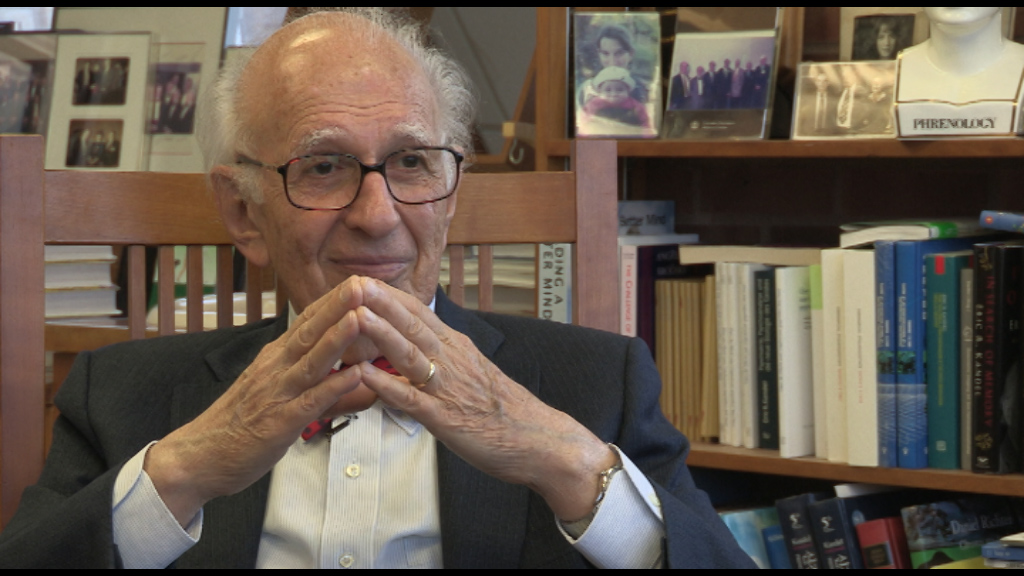NEXT STORY

An exceptionally rewarding year
RELATED STORIES

NEXT STORY

An exceptionally rewarding year
RELATED STORIES


|
Views | Duration | |
|---|---|---|---|
| 21. I decide to learn how memory works | 148 | 04:04 | |
| 22. Working with Alden Spencer | 97 | 02:38 | |
| 23. Thrilling discoveries about intracellular activity | 99 | 02:35 | |
| 24. Discovering Aplysia | 205 | 02:16 | |
| 25. I’m a Harvard snob! | 144 | 02:56 | |
| 26. Goldfish brains | 103 | 01:12 | |
| 27. I begin to work on Aplysia | 119 | 02:36 | |
| 28. Using Aplysia to study the neuroscience of behavior | 176 | 02:43 | |
| 29. Investigating the mechanisms of learning and memory | 137 | 04:43 | |
| 30. Working with Ladislav Tauc | 91 | 03:41 |


Ladislav Tauc was a perfect match as a mentor to me. He was not very much older than me, so we were sort of chronological peers. And he had a strong background in biophysics. He, for his thesis, studied the electrical properties of plants. He did intracellular recordings from giant plant cells and then he moved to Aplysia where the giant cells were similar to plant cells, he recorded primarily what we now call R2, a large giant cell in Aplysia in the abdominal ganglia. And he showed, as had been shown in the mammalian nervous system that the action potential initiated in the initial segment of the axon. He had never thought about behavior, he hadn’t thought much about integrative action, he hadn’t thought much about neural circuits. That was not his interest. His interest was biophysics and cellular neurobiology. I didn’t know much biophysics, I knew a modest amount about cellular biology, not as much as he did, but I had a broader perspective on it. So when I outlined for him the idea of looking at cellular analogues he was at first ambivalent, but then allowed me to do it. He gave me a great deal of freedom. And I proceeded to do it, and I couldn’t have been more surprised, but these things worked quite well.
I recorded from R2, I stimulated a pathway repeatedly, and I saw the synaptic potential go down. If I waited a little bit, it gradually came back. It was down for minutes. If I stimulated the pathway just rarely, and came in with another pathway, what we call heterosynaptic, very strongly, I produced dramatic facilitation of the first pathway. Heterosynaptic facilitation. Extremely nice. And again, that persisted for long periods of time. And amazingly, in cells near R2, we found that if you paired the two in the way of classical conditioning, with a weak stimulus just barely preceding the strong stimulus, you could produce pairing dependent facilitation. Classical conditioning. This was quite remarkable. And we summarized this in a series of papers, in which we said this is just an analogue of learning, but it suggests that similar mechanisms may be involved in the learning process, per se, because clearly built into the synapse is the capability for changing, and changing in both directions: it could go down, the same synapse could go down, it could go up. And although we could not isolate individual monosynaptic connections, we did try to do sort of threshold stimulation in which we could convince ourselves; it was not the most compelling evidence in the world, but quite suggestive, when stimulating a single fiber, we could see an elementary synaptic potential. And we could see some of these events in the elementary level.
So this is completely encouraging. And it gave me a sort of different view of how things work. Really if one could be so bold as to say, modification of Cajal’s view, there’s not a single learning process as Cajal thought about it. Learning is a family of different processes, and it utilizes a family of different mechanisms.
Eric Kandel (b. 1929) is an American neuropsychiatrist. He was a recipient of the 2000 Nobel Prize in Physiology or Medicine for his research on the physiological basis of memory storage in neurons. He shared the prize with Arvid Carlsson and Paul Greengard. Kandel, who had studied psychoanalysis, wanted to understand how memory works. His mentor, Harry Grundfest, said, 'If you want to understand the brain you're going to have to take a reductionist approach, one cell at a time.' Kandel then studied the neural system of the sea slug Aplysia californica, which has large nerve cells amenable to experimental manipulation and is a member of the simplest group of animals known to be capable of learning. Kandel is a professor of biochemistry and biophysics at the College of Physicians and Surgeons at Columbia University. He is also Senior Investigator in the Howard Hughes Medical Institute. He was the founding director of the Center for Neurobiology and Behavior, which is now the Department of Neuroscience at Columbia University. Kandel's popularized account chronicling his life and research, 'In Search of Memory: The Emergence of a New Science of Mind', was awarded the 2006 Los Angeles Times Book Award for Science and Technology.
Title: Working with Ladislav Tauc
Listeners: Christopher Sykes
Christopher Sykes is an independent documentary producer who has made a number of films about science and scientists for BBC TV, Channel Four, and PBS.
Tags: Aplysia, Ladislav Tauc
Duration: 3 minutes, 41 seconds
Date story recorded: June 2015
Date story went live: 04 May 2016